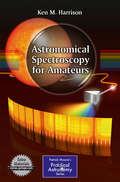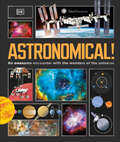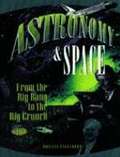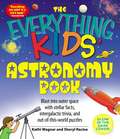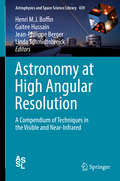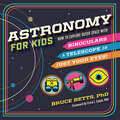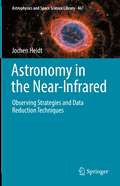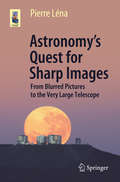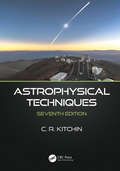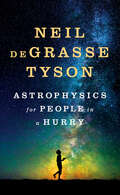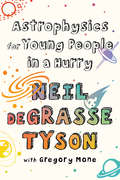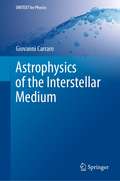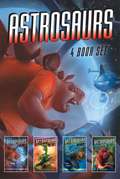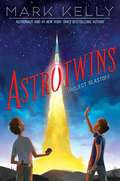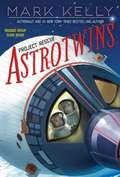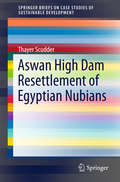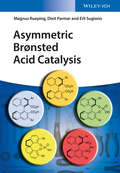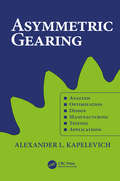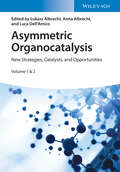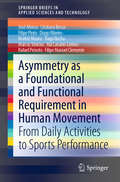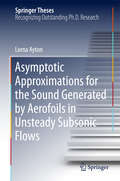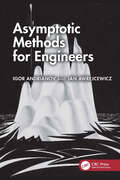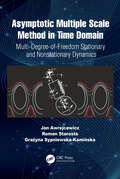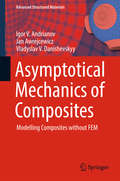- Table View
- List View
Astronomical Spectroscopy for Amateurs (The Patrick Moore Practical Astronomy Series)
by Ken M. HarrisonAstronomical Spectroscopy for Amateurs is a complete guide for amateur astronomers who are looking for a new challenge. After a brief overview of the development of spectroscopes and an introduction to the theory of stellar spectra, the book goes on to examine the various types of spectroscopes available to amateurs. Next, practical sections address all aspects of setting-up and using various types of commercially-available and home-built spectroscopes. A final part gives detailed instructions for the design and construction of three different spectroscopes, along with the necessary design theory (minimal math). The home-made spectroscopes have performance capabilities near or equal to commercial units but are constructed using basic hand tools for a fraction of the cost! This up-to-date practical spectroscopy book will enable amateur astronomers to develop the skills and equipment needed to prepare scientifically acceptable spectra data, and to make a valuable contribution to ProAm projects.
Astronomical!: An Awesome Encounter with the Wonders of the Universe
by DKAn awesome encounter with the wonders of the Universe.Behold a cosmic treasure trove of spectacular photographs that captures space as you've never seen it before in this space book for children aged 9+.Mind-blowing new images made possible by the latest technology can now take us to the heart of the Universe–from swirling dust devils on Mars, to emerging stars in nebulas, supermassive storms on Jupiter, as well as galaxies, comets, asteroids, and much more.This space book for children offers: Fast facts and amazing stats that highlight the mind-blowing wonders of the Solar System and the Universe.A collection of spectacular images captured by the latest space telescope, the James Webb, as well as mesmerizing images from Hubble and other spacecraft.Content endorsed and authenticated by Smithsonian.Astronomical! is the perfect gift to inspire young stargazers and astronomers. Every double page features a magnificent celestial body alongside fascinating and informative text that brings to life the wonder of outer space. Additional facts and comparisons provide readers with key information at a glance.
Astronomy & Space: From the Big Bang to the Big Crunch (Volume 3, Q-Z)
by Phillis EngelbertFeatures include approximately 300 entries; approximately 240 illustrations; sidebars; a historical timeline of famous astronomers, events and discoveries; glossary of terms; and a cumulative index.
Astronomy Book (The Everything Kids')
by Kathi Wagner Sheryl RacineExplore the galaxies!Aliens, space ships, and constellations, oh my! Ride on a rocket ship to another galaxy with this stellar book. With The Everything Kids' Astronomy Book, astronomers-in-training will learn:How galaxies like the Milky Way were built.Why the sun's surface is 20,000-50,000-degrees Fahrenheit.Why the earth spins and how gravity works.What comets and asteroids are made of and how they affect planets.The truth about the man in the moon.Why Mars is so hot and what those rings around Saturn are.What scientists think about aliens and life in outer spaceIf you want to build a sky-watching kit or change your room into a small universe, this book will take you on a journey that is out-of-this-world!
Astronomy at High Angular Resolution: A Compendium of Techniques in the Visible and Near-Infrared (Astrophysics and Space Science Library #439)
by Henri M. J. Boffin Gaitee Hussain Jean-Philippe Berger Linda SchmidtobreickThis book offers an essential compendium of astronomical high-resolution techniques. Recent years have seen considerable developments in such techniques, which are critical to advances in many areas of astronomy. As reflected in the book, these techniques can be divided into direct methods, interferometry, and reconstruction methods, and can be applied to a huge variety of astrophysical systems, ranging from planets, single stars and binaries to active galactic nuclei, providing angular resolution in the micro- to tens of milliarcsecond scales. Written by experts in their fields, the chapters cover adaptive optics, aperture masking imaging, spectra disentangling, interferometry, lucky imaging, Roche tomography, imaging with interferometry, interferometry of AGN, AGN reverberation mapping, Doppler- and magnetic imaging of stellar surfaces, Doppler tomography, eclipse mapping, Stokes imaging, and stellar tomography. This book is intended to enable a next generation of astronomers to apply high-resolution techniques. It informs readers on how to achieve the best angular resolution in the visible and near-infrared regimes from diffraction-limited to micro-arcsecond scales.
Astronomy for Kids: How to Explore Outer Space with Binoculars, a Telescope, or Just Your Eyes!
by Dr. Bruce BettsIgnite their passion for exploring the night sky—the astronomer's guidebook for kids ages 7 to 13"No matter how many times you've orbited the Sun, Astronomy for Kids is really for kids of all ages. Dr. Betts shows you how to become an astronomer—an observer of the stars. With this book, you can know the cosmos and your place within it. Read on, walk out, and look up!"—Bill Nye, science educator, author, and CEO of The Planetary SocietyOne of the coolest things about outer space is that anyone can explore it. All you have to do is go outside and look up! Using plain sight, binoculars, or a small telescope, Astronomy for Kids shows stargazers how easy it is to explore space, just by stepping outside.With this book as their guide to the northern hemisphere, kids will learn to find and name amazing objects in the night sky. Fully illustrated with fun facts throughout, kids can point out sights to friends and family, saying things like, "that's Jupiter," and, "those stars are the constellation Cygnus the Swan," and maybe even, "that group of stars doesn't have a name but I think it looks like my dog getting belly rubs."From the Milky Way Galaxy to Mars to the Moon's craters and mountains—Astronomy for Kids helps young astronomers discover important parts of our solar system, with:30 sights for the naked eye (yes, 30!) objects to see without any equipment, including Orion's Belt, the Big Dipper, Mars, and even the International Space Station.25 sights magnified with binoculars or a basic telescope to make objects in the sky easier to find and explore. Plus, buying tips and usage tricks to get the most out of astronomy equipment.Clear illustrations that show kids where to look and what they can expect to see.Like all big things, outer space is something you have to see to believe. Astronomy for Kids teaches kids that planets, shooting stars, constellations, and meteor showers are not only in books—but right above them.
Astronomy in the Near-Infrared - Observing Strategies and Data Reduction Techniques (Astrophysics and Space Science Library #467)
by Jochen HeidtNear-infrared astronomy has become one of the most rapidly developing branches in modern astrophysics. Innovative observing techniques, near-infrared detectors with quantum efficiencies in excess of 90%, highly specialised instruments as well as advanced data reduction techniques have allowed major breakthroughs in various areas like exoplanets, star-forming regions, the supermassive black hole in the Galactic center, and the high-redshift Universe. In this book, the reader will be introduced to the basic concepts of how to prepare near-infrared observations with maximized scientific return. Equal weight is given to all aspects of the data reduction for both - imaging and spectroscopy. Information is also provided on the state of the art instrumentation available and planned, on detector technology or the physics of the atmosphere, all of which influence the preparation and execution of observations and data reduction techniques. The beginner but also the expert will find a lot of information in compact form which is otherwise widely dispersed across the internet or other sources.
Astronomy’s Quest for Sharp Images: From Blurred Pictures to the Very Large Telescope (Astronomers' Universe)
by Pierre LénaSince the 1960s, astrophysical discoveries have blossomed, due to the emergence of powerful and new observational tools. Among them, a fantastic improvement of the sharpness of astronomical images, obtained with ground based optical telescopes, has been the result of two revolutions: adaptive optics and optical interferometry. Written for a general audience, interwoven with fascinating details about the evolution of vision and optics, this book tells a personal story of these revolutions in observational astronomy, born two centuries ago and blossoming in the past fifty years. With the construction of the Very Large Telescope in Chile, Europe played a leading role where young scientists, joining creative astronomers and engineers, have developed a superb creativity. Today, incredibly sharp images of exoplanetary systems and black hole environments are obtained and reveal new questions about Earth-like objects or fundamental physics. The author has been one of the actors of this adventure. His first-hand testimony is opening the future to new horizons.
Astrophysical Techniques
by C.R. KitchinLong used in undergraduate and introductory graduate courses, Astrophysical Techniques, Seventh Edition provides an accessible yet comprehensive account of the innovate instruments, detectors, and techniques employed in astronomy and astrophysics. Emphasizing the underlying unity of all astronomical observations, this popular textbook provides a coherent state-of-the-art account of the instruments and techniques used in current astronomy and astrophysics. Fully updated throughout, this seventh edition builds upon the sixth edition, covering improved techniques and cutting-edge methods in the field, as well as other exciting new developments in gravitational waves, dark matter and energy, the use of photonics, and astronomy education and outreach, in addition to further detailed discussions on the latest scientific instruments and individual detectors. The book is written in a very accessible manner, and most of the mathematics is accessible to those who have attended a mathematics course in their final years at school. Nevertheless, the treatment of the topics in general is at a sufficiently high level to be of use to those professionals seeking technical information in areas of astronomy with which they might not be completely familiar. Key Features: Details the instrumentation and theory of astronomical observations, including radio waves, gamma rays, cosmic rays, neutrinos, gravitational waves and dark matter and energy and more Presents the background theory and operating practice of state-of-the-art detectors and instruments Fully updated to contain the latest technology and research developments
Astrophysics for People in a Hurry
by Neil DeGrasse Tyson<P>The essential universe, from our most celebrated and beloved astrophysicist. <P>What is the nature of space and time? How do we fit within the universe? How does the universe fit within us? There’s no better guide through these mind-expanding questions than acclaimed astrophysicist and best-selling author Neil deGrasse Tyson. But today, few of us have time to contemplate the cosmos. So Tyson brings the universe down to Earth succinctly and clearly, with sparkling wit, in tasty chapters consumable anytime and anywhere in your busy day. <P>While you wait for your morning coffee to brew, for the bus, the train, or a plane to arrive, Astrophysics for People in a Hurry will reveal just what you need to be fluent and ready for the next cosmic headlines: from the Big Bang to black holes, from quarks to quantum mechanics, and from the search for planets to the search for life in the universe. <P><b>A New York Times Bestseller</b>
Astrophysics for Young People in a Hurry
by Neil deGrasse TysonNeil deGrasse Tyson’s #1 New York Times best-selling guide to the cosmos, adapted for young readers. From the basics of physics to big questions about the nature of space and time, celebrated astrophysicist and science communicator Neil deGrasse Tyson breaks down the mysteries of the cosmos into bite-sized pieces. Astrophysics for Young People in a Hurry describes the fundamental rules and unknowns of our universe clearly—and with Tyson’s characteristic wit, there’s a lot of fun thrown in, too. This adaptation by Gregory Mone includes full-color photos, infographics, and extra explanations to make even the trickiest concepts accessible. Building on the wonder inspired by outer space, Astrophysics for Young People in a Hurry introduces an exciting field and the principles of scientific inquiry to young readers.
Astrophysics of the Interstellar Medium (UNITEXT for Physics)
by Giovanni CarraroThis book is based on a series of lectures for an Astrophysics of the Interstellar Medium (ISM) master’s degree in Astrophysics and Cosmology at Padova University. From the cold molecular phase in which stars and planetary systems form, to the very hot coronal gas that surrounds galaxies and galaxy clusters, the ISM is everywhere. Studying its properties is vital for the exploration of virtually any field in astronomy and cosmology. These notes give the student a coherent and accurate mathematical and physical approach, with continuous references to the real ISM in galaxies. The book is divided into three parts. Part One introduces the equations of fluid dynamics for a system at rest and acoustic waves, and then explores the real ISM through the role of thermal conduction and viscosity, concluding with a discussion of shock waves and turbulence. In Part Two, the electromagnetic field is switched on and its role in modulating shock waves and contrasting gravity is studied. Part Three describes dust and its properties, followed by the main stellar sources of energy. The last two chapters respectively address the various components of the ISM and molecular clouds and star formation.
Astrosaurs 4 Book Set
by Steve Cole Various ArtistsExplore space with dynamic dinos in this set of four out-of-this-world adventures.It turns out that dinosaurs, despite their itty-bitty brains, were really pretty smart. They managed to escape the Earth in spaceships long before the meteors hit, and now travel among the stars of the Jurassic Quadrant, exploring new worlds, fighting evil, and keeping space safe.This eBook boxed set includes four stellar Astrosaur adventures: Riddle of the Raptors, The Hatching Horror, The Seas of Doom, and The Mind-Swap Menace.
Astrotwins -- Project Blastoff
by Martha Freeman Mark KellyA team of middle schoolers prepares for blastoff in this adventure from the author of the New York Times bestselling Mousetronaut, based on the childhoods of real-life astronauts Mark Kelly and his twin brother Scott.It's a long, hot summer and Scott and Mark are in big trouble for taking apart (aka destroying) their dad's calculator. As a punishment, they're sent to their grandfather's house, where there's no TV and they have to do chores. And Grandpa is less tolerant of the twins' constant bickering. "Why don't you two work together on something constructive. What if you built a go-kart or something?" Grandpa suggests. But it's not a go-kart the twins are interested in. They want to build a rocket. With the help of Jenny, nicknamed Egg, and a crew of can-do kids, they set out to build a real rocket that will blast off and orbit the Earth. The question soon becomes: which twin will get to be the astronaut? Written by a NASA astronaut with four space flights under his belt, this exciting story includes extensive back matter on the space program with fantastic facts and details.
Astrotwins -- Project Rescue
by Martha Freeman Mark KellyTwins Mark and Scott discover an abandoned Apollo command module and take off to rescue a stranded Russian cosmonaut in the second Astrotwins adventure from retired NASA astronaut and the #1 New York Times bestselling author of Mousetronaut, Mark Kelly.Mark and Scott Kelly, who are mostly known for getting in trouble, are finally back from their first space adventure. The twins have wanted to explore space ever since they were little and watched Neil Armstrong walk on the moon. And when they hear that a Russian cosmonaut is trapped inside the Salyut space station now orbiting 220 miles above the surface of the Earth, they wish they could find a way to help. While staying in the countryside at their grandfather's house with their friend Jenny (aka Egg), the twins repurpose a NASA Titan 2 rocket ship being stored nearby. Complete with spacesuits and snacks, the twins take off to rescue the Russian spacecraft. Will they ever see their family or their grandfather's backyard again? Written by a NASA astronaut with four space flights under his belt, the second exciting Astrotwins story includes extensive back matter on the space program with fantastic facts and details.
Aswan High Dam Resettlement of Egyptian Nubians (SpringerBriefs on Case Studies of Sustainable Development)
by Thayer ScudderThis book highlights the long-term resettlement process of the Egyptian Nubian people along the Aswan High Dam. Assessing the resettlement of 48,000 Egyptian Nubians in connection with the High Dam is especially important for three main reasons: firstly, this resettlement process is one of the rare cases in which research begun before the dam was built has continued for over forty years. Secondly, the resettlement of the Egyptian Nubian people is one of the few cases in which the living standards of the large majority improved because of the initial political will of the government, combined with Nubian initiatives. Thirdly, given the complexity of the resettlement process, weaknesses in government planning, implementation, and in the weakening of government political provide valuable lessons for future dam-induced resettlement efforts.
Asymmetric Bronsted Acid Catalysis
by Erli Sugiono Dixit Parmar Magnus RuepingA much-needed overview of the synthesis of chiral Brønsted acids and their applications in various organic transformations. The internationally recognized and highly respected expert authors summarize the most significant advances in this new and dynamically progressing field, with a special emphasis on BINOL-derived phosphoric acids. They also describe other catalysts, such as C-H, TADDOL-derived Brønsted, and sulfonic acids. For easy navigation, the chapters are organized in the first instance according to reactive intermediate and then sub-divided by reaction type.An appendix with selected experimental details for benign and straight-forward procedures rounds of the book, making this the number-one information source for organic chemists in academia and industry.
Asymmetric Dual Core Waveguides: Dynamics of Self-Similar Waves (Progress in Optical Science and Photonics #22)
by Soloman Raju ThokalaThis book highlights the dynamical behavior of self-similar waves in asymmetric dual-core waveguides. The proposed dual-core waveguide consists of two closely spaced adjoining fibers in which one fiber is active and the other is passive. Due to the linear coupling between them, the dynamics of the wave propagating through the passive core can be controlled by manipulating the dynamics of the wave propagating in the active core. The optimal pulse compression or amplification of these waves as the length of the fiber tends to infinity is presented. The exact Mobius transform self-similar solutions that propagate through these waveguides self-similarly are subject to simple scaling rules. The book includes experiments conducted to corroborate the analytical predictions.
Asymmetric Gearing
by Alexander L. KapelevichThe history of gears with asymmetric teeth is not sufficiently recorded in modern gear literature, with some gear researchers concluding that asymmetric tooth gears were discovered just several decades ago. This book sheds light upon the origins and state of asymmetric gearing, referencing technical articles from the 19th, 20th, and 21st centuries. As a practicing gear engineer with over 40 years’ experience, author Alexander L. Kapelevich has successfully implemented asymmetric gears in a variety of custom gear transmissions. This book addresses all aspects of asymmetric gear development, including theoretical fundamentals; tooth geometry optimization; stress analysis and rating; design and production specifics; analytical and experimental comparison to the best symmetric gears; and application examples. Readers are encouraged to look beyond the status quo established by traditional gear design, and to apply principles of asymmetric gearing to actual gear design. Optimal solutions are presented for gear drives that will maximize technical performance and marketability. Features Presents a state-of the-art, comprehensive historical overview of asymmetric gearing Explains the Direct Gear Design® approach to asymmetric gear design Describes asymmetric tooth gear geometry optimization, areas of existence, and parameter selection limits Considers practical aspects of asymmetric gear fabrication and measurement Presents analytical and experimental comparison of asymmetric gears to advanced symmetric gears, showing the advantages of asymmetric designs Provides numerous real-world examples of asymmetric gear application
Asymmetric Organocatalysis: New Strategies, Catalysts, and Opportunities, 2 Volumes
by Lukasz AlbrechtAsymmetric Organocatalysis Comprehensive resource on the latest and most important developments in the highly vivid field of asymmetric organocatalysis The book provides a comprehensive overview of the most important advancements in the field of asymmetric organocatalysis that have occurred within the last decade. It presents valuable examples of newly developed synthetic methodologies based on various organocatalytic activation modes. Special emphasis is given to strategies where organocatalysis is expanding its potential by pushing the boundaries and founding new synergistic interactions with other fields of synthetic chemistry, such as metal catalysis, photocatalysis, and biocatalysis. The application of different concepts (such as vinylogy, dearomatization, or cascade reactivity), resulting in the development of new functionalization strategies, is also discussed. Sample topics covered within the book include: New developments in enantioselective Brønsted acid catalysis with strong hydrogen-bond donors Asymmetric phase-transfer catalysis, from classical applications to new concepts Halogen-bonding organocatalysis Asymmetric electrochemical organocatalysis and synergistic organo-organocatalysis Immobilized organocatalysts for enantioselective continuous flow processes Mechanochemistry and high-pressure techniques in asymmetric organocatalysis Useful tools in elucidation of organocatalytic reaction mechanisms With an overall focus on new reactions and catalysts, this two-volume work is an indispensable source for everyone working in the field of asymmetric organocatalysis.
Asymmetry as a Foundational and Functional Requirement in Human Movement: From Daily Activities to Sports Performance (SpringerBriefs in Applied Sciences and Technology)
by Filipe Manuel Clemente José Afonso Cristiana Bessa Filipe Pinto Diogo Ribeiro Beatriz Moura Tiago Rocha Marcus Vinícius Rui Canário-Lemos Rafael PeixotoThis book describes the structural and functional asymmetries in human body movement by providing cases and examples using illustrations and easy-to-understand scenarios. Specifically, it adopts an evidence-based approach to demonstrate (i) the role of structural (e.g., bone dimensions) and functional (e.g., hemispheric dominance) asymmetries in the human body; (ii) the asymmetric nature of most daily activities (e.g., gait, mastication); (iii) the benefits of asymmetry for physical performance; and (iv) the role of asymmetry in preventing injury. More than just a scientific book, it bridges the gap between theory and practice, and includes practical examples and applications. The book appeals to academics and practitioners in the fields of kinesiology, human movement, sports sciences, strength and conditioning, and physiotherapy.
Asymptotic Approximations for the Sound Generated by Aerofoils in Unsteady Subsonic Flows (Springer Theses)
by Lorna AytonThis thesis investigates the sound generated by solid bodies in steady subsonic flows with unsteady perturbations, as is typically used when determining the noise generated by turbulent interactions. The focus is predominantly on modelling the sound generated by blades within an aircraft engine, and the solutions are presented as asymptotic approximations. Key analytical techniques, such as the Wiener-Hopf method, and the matched asymptotic expansion method are clearly detailed. The results allow for the effect of variations in the steady flow or blade shape on the noise generated to be analysed much faster than when solving the problem numerically or considering it experimentally.
Asymptotic Methods for Engineers
by Jan Awrejcewicz Igor V. AndrianovAsymptotic Methods for Engineers is based on the authors’ many years of practical experience in the application of asymptotic methods to solve engineering problems.This book is devoted to modern asymptotic methods (AM), which is widely used in engineering, applied sciences, physics, and applied mathematics. Avoiding complex formal calculations and justifications, the book’s main goal is to describe the main ideas and algorithms. Moreover, not only is there a presentation of the main AM, but there is also a focus on demonstrating their unity and inseparable connection with the methods of summation and asymptotic interpolation.The book will be useful for students and researchers from applied mathematics and physics and of interest to doctoral and graduate students, university and industry professors from various branches of engineering (mechanical, civil, electro-mechanical, etc.).
Asymptotic Multiple Scale Method in Time Domain: Multi-Degree-of-Freedom Stationary and Nonstationary Dynamics
by Jan Awrejcewicz Roman Starosta Grażyna Sypniewska-KamińskaThis book offers up novel research which uses analytical approaches to explore nonlinear features exhibited by various dynamic processes. Relevant to disciplines across engineering and physics, the asymptotic method combined with the multiple scale method is shown to be an efficient and intuitive way to approach mechanics. Beginning with new material on the development of cutting-edge asymptotic methods and multiple scale methods, the book introduces this method in time domain and provides examples of vibrations of systems. Clearly written throughout, it uses innovative graphics to exemplify complex concepts such as nonlinear stationary and nonstationary processes, various resonances and jump pull-in phenomena. It also demonstrates the simplification of problems through using mathematical modelling, by employing the use of limiting phase trajectories to quantify nonlinear phenomena. Particularly relevant to structural mechanics, in rods, cables, beams, plates and shells, as well as mechanical objects commonly found in everyday devices such as mobile phones and cameras, the book shows how each system is modelled, and how it behaves under various conditions. It will be of interest to engineers and professionals in mechanical engineering and structural engineering, alongside those interested in vibrations and dynamics. It will also be useful to those studying engineering maths and physics.
Asymptotical Mechanics of Composites: Modelling Composites without FEM (Advanced Structured Materials #77)
by Jan Awrejcewicz Igor V. Andrianov Vladyslav V. DanishevskyyIn this book the authors show that it is possible to construct efficient computationally oriented models of multi-parameter complex systems by using asymptotic methods, which can, owing to their simplicity, be directly used for controlling processes arising in connection with composite material systems. The book focuses on this asymptotic-modeling-based approach because it allows us to define the most important out of numerous parameters describing the system, or, in other words, the asymptotic methods allow us to estimate the sensitivity of the system parameters. Further, the book addresses the construction of nonlocal and higher-order homogenized models. Local fields on the micro-level and the influence of so-called non-ideal contact between the matrix and inclusions are modeled and investigated. The book then studies composites with non-regular structure and cluster type composite conductivity, and analyzes edge effects in fiber composite materials. Transition of load from a fiber to a matrix for elastic and viscoelastic composites, various types of fiber composite fractures, and buckling of fibers in fiber-reinforced composites is also investigated. Last but not least, the book includes studies on perforated membranes, plates, and shells, as well as the asymptotic modeling of imperfect nonlinear interfaces.
